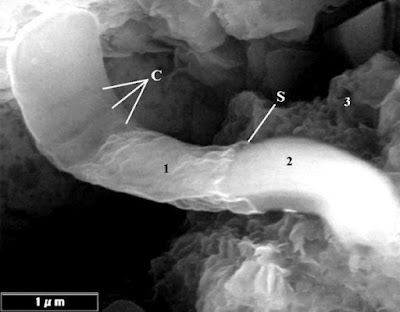Quackery? Maybe, maybe not. This linked article is an example of how scientific/secular truth is initiated and responded to. First, a discovery is given meaning - in this case, electromicroscopic findings inside meteorites are presented to support a conjecture or provisional scientific theory regarding the extra-terrestrial origin of life on Earth. Such conjectures are presented to the scientific community for confirmation as truth. Members of this community typically try to confirm or refute the conjecture by replicating its experimental or observational evidence and methods, and by testing the reasoning accompanying it. The link at the bottom of this post is one effort to refute the evidence presented to support the conjecture of life's extra-terrestrial origins.
The strength of scientific truths vary in terms of how well or ill they withstand efforts to refute them. The process of scientific conjecture and refutation continues regarding the theory of Life's origins, as it does with all theories that make up scientific knowledge. So far, the supporting evidence and explanatory power of the theory of panspermia, that life first appeared extra-terrestrially, has not been sufficient to trump the evidence and explanatory power supporting other scientific explanations of the origin of life on Earth. Foremost among competing scientific theories of life's origins on Earth is abiogenesis or biopoesis, that life on Earth arose from Earth's inorganic matter.
Scientific theories that successfully withstand credible refutations are gradually regarded to be closer to truth than existing or competing theories that do not. All scientific truth is therefore provisional in that it must continually withstand attempted refutations. If an original scientific theory does not successfully survive its refutations, that is, if other scientific explanations of existing or new evidence provide a better account of the original evidence, then the original theory is modified or rejected in favor of the newer theory. In this way, scientific truth is established, grows and is improved.
See renowned philosopher of science Karl Popper's book Conjectures and Refutations: The Growth of Scientific Knowledge for a full explanation of this process as applied not only to the natural sciences but also to politics and history. This same approach to truth is applied to scientific understandings of Humankind's origins and behaviors, and our ideas and beliefs, including those of religion.
R. Hoover / Journal of Cosmology
A field-emission scanning electron micrograph shows one of the filaments
that was found in the Ivuna CI1 carbonaceous meteorite. The image includes
labels for data about elemental composition. The bar at lower left shows the
1-micron scale. The filament looks similar to those seen in earthly cyanobacteria.
A CONJECTURE:
Fossils of Cyanobacteria in CI1 Carbonaceous Meteorites: Implications to Life on Comets, Europa, and Enceladus by Richard B. Hoover, NASA/Marshall Space Flight Center, Huntsville, AL, Journal of Cosmology, Vol. 13, March 2011
- Definition of life: Arsenic debate just won't die
- Strange find on Titan sparks chatter about life
- Mars methane mystery: What's making the gas?
- Meteorite study revives debate over life on Mars
- Search for alien life may take giant leap forward
Not everyone is convinced. P.Z. Myers, a biologist at the University of Minnesota, has this to say:
Did Scientists Discover Bacteria in Meteorites?
Additional Reading
Did Bacteria Develop Into More Complex Cells Much Earlier in Evolution Than Thought?
